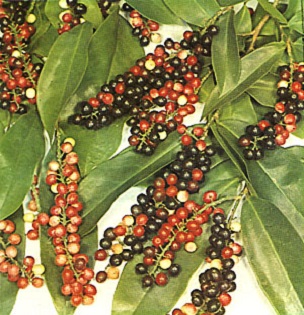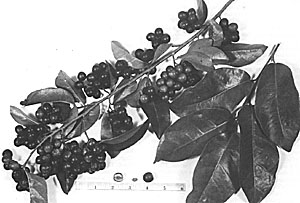From the book
Fruits of Warm Climates
by Julia F. Morton
Bignay
Antidesma bunius Spreng.
EUPHORBIACEAE
When Corner referred to this member of the Euphorbiaceae as a
"shady, rather gloomy tree", he could not have been viewing it in
fruit, a spectacle that has always aroused enthusiasm. The colorful
bignay, Antidesma bunius
Spreng., is called bignai in the Philippines; buni or berunai in
Malaya; wooni or hooni, in Indonesia; ma mao luang in Thailand; kho
lien tu in Laos; choi moi in Vietnam; moi-kin and chunka by the
aborigines in Queensland. Among English names are Chinese laurel,
currant tree, nigger's cord, and salamander tree.
Description
The tree may be shrubby, 10 to 26 ft (3-8 m) high, or may reach up to
50 or even 100 ft (15-30 m). It has wide-spreading branches forming a
dense crown. The evergreen, alternate leaves are oblong, pointed, 4 to
9 in (10-22.5 cm) long, 2 to 3 in (5-7.5 cm) wide, dark-green, glossy,
leathery, with very short petioles. The tiny, odorous, reddish male and
female flowers are produced on separate trees, the male in axillary or
terminal spikes, the female in terminal racemes 3 to 8 in (7.5-20 cm)
long. The round or ovoid fruits, up to 1/3 in (8 mm) across, are borne
in grapelike, pendent clusters (often paired) which are extremely showy
because the berries ripen unevenly, the pale yellowish-green, white,
bright-red and nearly black stages present at the same time. The skin
is thin and tough but yields an abundance of bright-red juice which
leaves a purple stain on fabrics, while the pulp, only 1/8 in (3 mm)
thick is white with colorless juice. Whole fruits are very acid, much
like cranberries, when unripe; are subacid, slightly sweet, when fully
ripe. Some tasters detect a bitter principle or "unpleasant aftertaste"
which is unnoticeable to others. There is a single, straw-colored
stone, an irregular, flattened oval, ridged or fluted, very hard, 3/8
in (1 cm) long, 1/4 in (6 mm) wide.
P.J. Wester mentions a "very distinct and superior variety" as reliably reported from the Mountain Province, Philippines.

Plate XXVI: BIGNAY, Antidesma bunius
Origin and
Distribution
The
bignay is native and common in the wild from the lower Himalayas in
India, Ceylon, and southeast Asia (but not Malaya) to the Philippines
and northern Australia. It is an abundant and invasive species in the
Philippines; occasionally cultivated in Malaya; grown in every village
in Indonesia where the fruits are marketed in clusters.
The
United States Department of Agriculture received seeds from the
Philippines in 1905 (S.P.I. #18393); twice in 1913 (S.P.I. #36088 and
#34691), and again in 1918 (S.P.I. #46704). Quite a few trees have been
planted in southern Florida in the past and the fruits were formerly
appreciated as a source of juice for jelly, commercialized in a limited
way, but are rarely so used today. There are specimens in experimental
stations in Cuba, Puerto Rico, Honduras and Hawaii.
Climate
The
tree is not strictly tropical for it has proved to be hardy up to
central Florida. It thrives in Java from sea-level to 4,000 ft (1,200
m). It grows well and flowers but does not set fruit in Israel.
Propagation
Many
seeds are non-viable in Florida, perhaps because of inadequate
pollination. Since seedlings may turn out to be male, and female
seedlings may not bear for a number of years, vegetative propagation is
preferred. The tree is readily multiplied by cuttings, grafting or
air-layering. The air-layers have borne fruit in 3 years after
transplanting to the field. Ochse recommends grafting in the wet season
because scions will remain dormant in dry weather. Most female trees
will bear some fruit without the presence of a male because many of the
flowers are perfect.
Culture
The trees should be
spaced 40 to 45 ft (12-14 m) apart, each way. And one male tree should
be planted for every 10 to 12 females to provide cross-pollination.
Wind-protection is desirable when the trees are small. Otherwise they
require very little cultural attention.
Yield
Yield varies greatly
from tree to tree if they are grown from seed. A mature tree in Florida
has produced 15 bushels of fruit in a season. One very old tree at the
home of Dr. David Fairchild produced 22 bushels yielding 72 gals (273
liters) of juice.
Season
In
Indonesia, the trees flower in September and October and the fruits
mature in February and March. The fruiting season is July to September
in North Vietnam. In Florida it extends from late summer through fall
and winter because some trees bloom much later than others.
Pests and Diseases
The
tree is attacked by termites in Southeast Asia. In Florida, the leaves
may be heavily attacked by mealybugs and by scale insects and sooty
mold develops on their excretions. Here, also, the foliage is subject
to green scurf and algal leaf spot caused by Cephaleuros tirescens.
Food Uses
In
Malaya, the fruits are eaten mostly by children. Indonesians cook the
fruits with fish. Elsewhere the fruits (unripe and ripe together) are
made into jam and jelly though the juice is difficult to jell and
pectin must be added. Some cooks add lemon juice as well. If the
extracted bignay juice is kept under refrigeration for a day or so,
there will be a settling of somewhat astringent sediment which can be
discarded, thus improving the flavor. For several years, the
richly-colored jelly was produced on a small commercial scale in
southern Florida. The juice makes an excellent sirup and has been
successfully fermented into wine and brandy.
In Indonesia and
the Philippines, the leaves are eaten raw or stewed with rice. They are
often combined with other vegetables as flavoring.
| Food
Value Per
100 g of Edible Portion* |
| Moisture |
91.11-94.80 g |
| Protein |
0.75 g |
|
Ash |
0.57-0.78 g |
| Calcium |
0.12 mg |
Phosphorus
|
0.04 mg |
| Iron |
0.001 mg |
| Thiamine |
0.031 mg |
| Riboflavin |
0.072 mg |
| Niacin |
0.53 mg |
| *According
to analyses made in Florida and the Philippines. |
|
Toxicity
The bark contains a
toxic alkaloid. The heavy fragrance of the flowers, especially the
male, is very obnoxious to some individuals.
Other Uses
Bark: The bark yields a strong fiber for rope and cordage.
Wood:
The timber is reddish and hard. If soaked in water, it becomes heavy
and, according to Drury, "black as iron". It has been experimentally
pulped for making cardboard.
Medicinal Uses: The leaves are sudorific and employed in treating snakebite, in Asia.
Related
Species
The Herbert River cherry, A. dallachyanum
Baill., is a bushy tree, seldom over 25 ft (7.5 m) in height. The young
shoots are slightly hairy. Mature leaves, almost hairless, are ovate to
lanceolate-elliptical, 2 to 6 in (5-15 cm) long; deep-green above,
bright-green beneath; thick and leathery. The odoriferous male flower
spikes are hairy, generally in panicles in the leaf axils, occasionally
solitary, more or less interrupted. The greenish female flowers are
borne in racemes. The fruits, single or in clusters of 4 to 30, are
round to obovoid, up to 3/4 in (2 cm) wide, rich-red when unripe, dark
purple-red (nearly black) when ripe and very acid. They ripen fairly
evenly in the cluster.

Fig. 55: The Herbert River Cherry of Australia (Antidesma dallachyanum) is less showy than the bignay but the fruits have more flesh
The
tree is native to coastal North Queensland, growing on the borders of
rain forests and on the banks of streams and lagoons. Seeds were
imported by the University of Florida Agricultural Research and
Education Center, Homestead, Florida, in 1941 and the seedlings grew
and bore well. The seeds germinate readily and seedlings begin to fruit
at about 6 years of age when they may be 8 ft (2.4 m) tall.
Multiplication may also be by cuttings, air-layering or grafting. One
nursery in Florida offered grafted plants for sale but they did not
become popular and the species is still rare.
In Australia, the
trees bloom from December to February and again in September and the
fruits mature in their fall and winter months. In Florida, blooming
takes place from April to June and the fruit is in season in September
and October.
The extracted juice is very dark-red, nearly black, but it yields, with the addition of pectin, a deep-red jelly.
The tree, like that of the bignay, is prone to infestation by mealybugs and scale insects and associated sooty mold.
The black currant tree, A. ghaesembilla Gaertn. (syn. A. pubescens
Roxb.), called dang kiep kdam in Cambodia, chop moi, choi moi, chua moi
or chum moi in Vietnam, is a deciduous shrub or bushy tree up to 26 or,
at most, 40 ft (8-12 m), with short, russet hairs on the young
branches, rosy new foliage and inflorescences. The mature leaves are
broad-ovate or nearly circular, 1 1/2 to 3 in (4-7.5 cm) long, glossy
on the upper surface. Male flower spikes, purplish or light-yellow with
pollen, are dense, 1 to 2 in (2.5-5 cm) long; the erect female shorter
and not as compact. Both types occur in terminal panicles or rarely
solitary. Some trees bear both male and female flowers but on separate
branches. The trees flower off and on during the year but mostly March
to May in Asia.
The fruit is velvety, dark-red or very
dark-purple, obliquely ovoid with one seed or occasionally double with
2 seeds. The seed kernels are sharply angular. When fully ripe the
fruit is subacid to somewhat sweet.
This species has a wide
natural range: in tropical Africa, and from the moist tropical lower
Himalayas in northern India through Ceylon, southern China, Southeast
Asia and Malaysia to the Walsh River region of Queensland. Generally
the fruits are eaten mainly by children, but they are appreciated as
thirst-quenchers by forest people of Thailand. They were made into jam
by early settlers in Australia. In Malaya and Indonesia, they are made
into a kind of relish, and the very young leaves are added as acid
flavoring to various foods.
The wood is red, hard,
close-grained, smooth and used for light rafters in huts, but for
little else. Small branches are lopped twice a year for fuel. In India,
the leaves are used to treat fever, headache and swollen abdomens. In
Cambodia, various parts of the tree are valued in native medicine. The
bark, combined with tobacco, is applied on wounds of animals. Combined
with the bark of other species, it is boiled and the decoction given to
halt diarrhea. The leaves and wood are similarly employed. A decoction
of young branches and papaya roots is considered an effective
emmenagogue. Crushed leaves are applied on the head of a newborn infant.
|
|